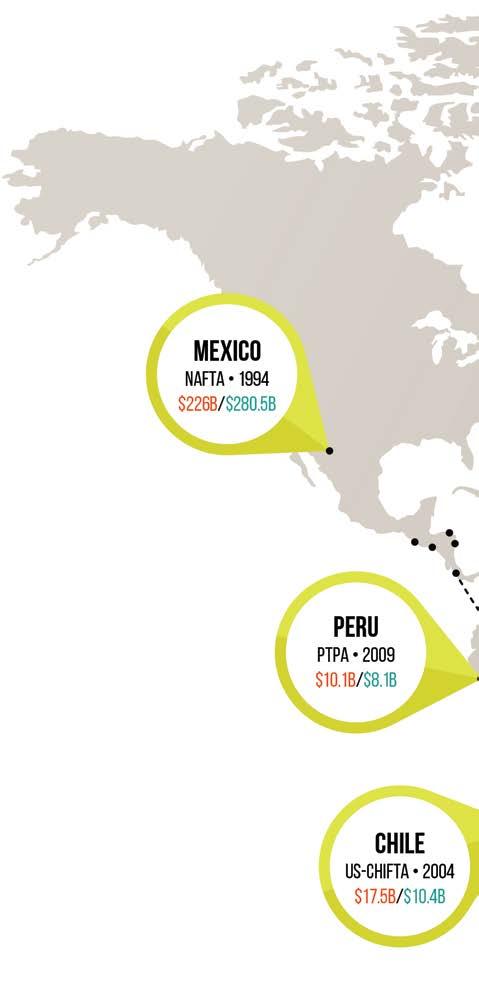
8 minute read
INTERNATIONAL TRADE
More than 80 percent of the world’s purchasing power resides outside the United States—that’s a lot of customers for U.S. businesses. More than one in five American jobs—38.1 million—depend on international trade. In addition, foreign-owned companies employ 5.3 million Americans.
Looking to the global marketplace for economic development and paying attention to export and import trends is no longer an option for state policymakers—it is a necessity.
A study by the International Trade Administration found that jobs in exporting industries actually pay better, with exports contributing an additional 18 percent to workers’ earnings on average in the U.S. manufacturing sector. That earnings premium is even higher for blue-collar workers, who get a 20 percent boost over white-collar workers.
While trade policy is largely handed down from Washington, state leaders must understand those policies—particularly how free trade agreements affect their state—as they craft their job growth strategies.
Although free trade agreements can be contentious, they are, at their essence, an agreement between two or more countries to abide by certain rules that affect trade and offer protections for investors and intellectual property rights. They are designed to reduce barriers to trade, protect U.S. competitive interests abroad and enhance the rule of law among partner countries.
UNITED STATES TRADE AGREEMENTS (2013)
IMPORTS EXPORTS
US-AUSFTA | U.S.-Australia Free Trade Agreement USBFTA | U.S.-Bahrain Free Trade Agreement NAFTA | North American Free Trade Agreement US-CHIFTA | The United States-Chile Free Trade Agreement CTPA | The United States-Colombia Trade Promotion Agreement CAFTA-DR | The United States-Central America
Dominican Republic Free Trade Agreement US-ISRFTA | The United States-Israel Free Trade Area Agreement US-JORFTA | The United States-Jordan Free Trade Area Agreement KORUS FTA | The United States-Korea Trade Agreement US-MOR FTA | The United States-Morocco Free Trade Agreement US-OMANFTA | The United States-Oman Free Trade Agreement US-PANTPA | The United States-Panama Trade Promotion Agreement PTPA | The United States-Peru Trade Promotion Agreement US-SINFTA | The United States-Singapore Free Trade Agreement Source: Office of Trade Representative
TOP 5 STATE MERCHANDISE EXPORTERS (2013)
Texas
California
New York
Washington Value of Merchandise Exports ($billions)
$279.49
$168.04
$86.52
$81.64
$66.09
State Share of National Exports
18%
11%
5%
5%

STATE EXPORTS
In 2013, exports supported 11.3 million jobs, 1.6 million more than in 2009. Nearly half of merchandise exports go to five countries—Canada, Mexico, China, Japan and Germany.
Texas exported the most merchandise of any state in 2013—18 percent of the market—followed by California with 11 percent and New York with 5 percent.
AGREEMENTS UNDER CONSIDERATION
Trans-Pacific Partnership The U.S. is in the process of negotiating a new free trade agreement, the Trans-Pacific Partnership. The TPP, as it is called, would build on pre-existing trade agreements with six countries—Australia, Canada, Chile, Mexico, Singapore and Peru. It also would develop new agreements with five countries—Brunei, Japan, Malaysia, New Zealand and Vietnam. In 2013, the U.S. exported nearly $700 billion in goods—or 44 percent of total U.S. exports—to TPP countries.
Trans-Atlantic Trade and Investment Partnership Negotiations to launch the Trans-Atlantic Trade and Investment Partnership, or T-TIP, were announced in 2013 and are ongoing. The agreement would set standards for trade and investment between the United States and the member states of the European Union. Trade among countries included in T-TIP account for one-third of world trade in goods and services and almost half of global economic output.

© C.J. Burton / Corbis
When President Obama announced in January a proposal to make the first two years of community college free, education experts say it was an important moment, but perhaps not for the reason most people think. It was important, they say, because of the conversations starting in homes and state capitols.
“The real importance in what the president is proposing is in the big, high-level conversations he’s starting,” said Debbie Cochrane, research director for the Institute for College Access and Success, an independent, nonprofit organization dedicated to making higher education more affordable and available. “He’s starting conversations about the importance of higher education and that it should really be universal at this point.”

Borrowing Tennessee’s Promise
Called America’s College Promise, President Obama’s plan gives students the chance to go to a community college tuition free for two years if they attend at least half-time, maintain a 2.5 grade point average and make steady progress toward completing their program.
The idea was based on Tennessee Gov. Bill Haslam’s signature achievement, the Tennessee Promise. The program is called a last-dollar scholarship. Students must apply for financial aid and others scholarships; the state picks up the tab for the amount left unfunded for two years.
“Tennessee Promise, it requires some skin in the game by the (student) too,” said Warren Nichols, vice chancellor for Tennessee’s Community Colleges. “They must do eight hours
by Jennifer Ginn
of community service per semester and they must also work with a mentor, which is an adult volunteer from the community.”
The first group of Tennessee Promise students enters college this fall. Nichols said the state is estimating the program will cost about $34 million per year, which will be funded by the proceeds of the state lottery. That money previously had been used to fund a different scholarship program.
“All of this is designed to get us a better educated citizenry in Tennessee, and obviously to give us a better educated workforce so that we can keep our quality of life in Tennessee high, keep unemployment rates low and keep our businesses and industries strong with a good workforce,” Nichols said. “Businesses and industry have been really supportive of this initiative.”
COMMUNITY COLLEGE INDIANAPOLIS—President Barack Obama answered audience questions at Ivy Tech Community College in February while promoting his budget proposal to make two years of community college free. © AP Photo / Evan Vucci

Nichols said nobody in the community college system has any idea about how many new students to expect this fall because of Tennessee Promise. Some high schools made all seniors apply. While the state was expecting 20,000 to 25,000 initial applicants, he said, more than 60,000 signed up. Additional deadlines are expected to whittle that number down.
“We believe that we may end up with an additional 10,000 to 12,000 students when all is said and done,” Nichols said. “But of that 10,000 to 12,000, we don’t know how many would have come to us anyway. We’re still guessing at what our numbers are going to be. On a short-term basis, we do believe we have the facility capability of handling and absorbing the students.”
While classroom space eventually may become a problem, said Nichols, a more immediate issue is paying for the instructors and support staff to help students succeed.
“There’s no additional state funding coming to support this influx of students other than the student tuition that will come with it, which we know only pays for a percentage of the cost of doing business,” he said. “We don’t have the funding to hire those additional staff. That’s where we’re scratching our heads, trying to make sure that the students who come to us in the fall of ’15 are going to have all the advantages and all the tools necessary from our level to make sure they’re successful.”
Nichols said Tennessee Promise is the beginning of a new conversation in the state about higher education.
“The conversation that has occurred with these 60,000 students who initially applied for Tennessee Promise, whether they had any intention of going or not, that is 60,000 individual conversations that are occurring about students going to college,” he said. “It’s a conversation they’re having with someone about their future in higher education. That’s a tremendous move forward right there.”

A Shift in Thinking
Dewayne Matthews, vice president of strategy development for the Lumina Foundation, said the president’s America’s College Promise initiative is an important move forward for higher education in the country. In his State of the Union speech, Obama connected higher education to both economic growth and economic security.
While people have heard the statistics that 60 percent of jobs will require some postsecondary education by 2018, Matthews said, those implications are beginning to sink in.
“It’s less about paying for college; that’s significant, affordability is a big issue,” he said. “But the real issue … was the question about whether we really need to shift our thinking as a nation that some form of postsecondary education should be expected, should be something that everybody gets or at least has access to it. The simplest way to assure that it is considered to be something that everybody needs and everybody should have access to is to make it free.”
Some detractors argue that promise-type programs—since they are not based on income—end up paying tuition for students who otherwise can pay their own way. “There’s no point in arguing that point,” Matthews said. “That’s absolutely true, just like there are people who go to high school who can afford to pay for that.
“The effect of it (promise-type programs) on behavior, the decision about whether or not to go to college, is greatest on lowincome students. While there may be more efficient ways, frankly, to target aid based on financial need, the overarching question is whether doing it this way, making it this simple and clear, actually sends a much more powerful message … that college is possible and that this is something they really should be doing.”
While many doubt Congress will approve America’s College Promise, Matthews said maybe that’s not the point.
“I think it will probably cause a lot more people to pay attention to these plans,” he said. “The broader public is now having this conversation about ‘wait a minute, should we be thinking about college more broadly?’ Is it time for another moment like the country made several times in the past, to recalibrate our thinking about how much education is enough? Have we reached that point where it’s now time to take another step? That, I think, is the conversation that this has prompted.”




